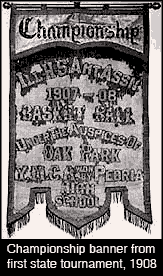
| Home | Betting Guide | Betting Tips | MM History | Schedule |


| NCAA Teams NCAA Bracket Live Odds |
|
|
|
|
|
|
|
|
A Brief History of March MadnessEvery year, as winter wanes, a curious ailment spreads across the country. The thump of basketballs, the squeak of sneakers, and the roar of the crowd are sure signals that basketball fever is with us. It's a condition called "March Madness," and it afflicts millions of people with no known cure. Where did this malady originate?
Giving It a Name It was an era of some of Illinois' most legendary teams, including the undefeated 1944 Taylorville squad and Mt. Vernon's unstoppable back-to-back champions of 1949 and 1950. But the one champion remembered more than any other is tiny Hebron, a school of only 99 students, which won the tournament in 1952. Making It Official "March Madness" grew as well. Beginning in 1973, the IHSA began using the term officially in its programs and on its merchandise. In 1977, the organization enlisted veteran Chicago sportswriter and Big Ten basketball referee Jim Enright to write the official history of the boys basketball tournament. The result was March Madness: The Story of High School Basketball in Illinois. As media technology advanced, the IHSA and KOST Broadcast Sales of Chicago produced March Madness: The Official Video History of the IHSA Basketball Tournament in 1989. Both the book and video were sold nationwide. During this period, the Illinois High School Association received trademark status for the term "March Madness" and registered the trademark "America's Original March Madness." The spirit of March Madness has subsequently spread from coast to coast, as other companies and organizations, including state high school associations and manufacturers, have been licensed by the IHSA to use these trademarks. March Madness Today The popularity of these events now allows the IHSA to provide more than just good entertainment for its fans. A significant portion of the fees generated from the licensing of the unified marks "March Madness" and "America's Original March Madness" are used to fund college scholarships for Illinois high school boys and girls.
|
|
NCAA Bracket - Live Odds - Links Page - Contact Us - Webmaster - Basketball News
 A Tradition is Born
A Tradition is Born